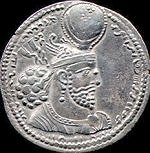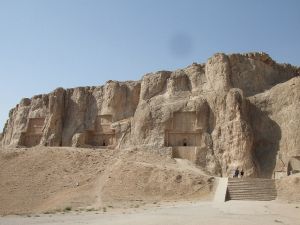Bahram II
Bahram II was the fifth Sassanid King of Persia in 276–293.
He was the son of Bahram I (273–276). During his reign, most of Armenia was lost to the Roman Empire and Emperor Marcus Aurelius Carus succeeded in reversing Rome's previous defeats at the hands of the Sassanids but died suddenly before he could
Biography
Bahram II succeeded his father in 276 as the fifth Sassanid ruler. Bahram II is said to have ruled at first tyrannically, and to have disgusted his principal nobles, who went so far as to form a conspiracy against him, intending to put him to death. The Zoroastrian high priest, Kartir, however, interposed, and, having alerted him of the threat, convinced him to acknowledge his wrong and to promise a change of conduct. The nobles upon this returned to their allegiance; and Bahram, during the remainder of his reign, is said to have been distinguished for wisdom and moderation, and to have become popular with all his subjects. Wiesehofer says that civil unrest forced Bahram to "cooperate more closely with the aristocracy and clergy."[1]
In 283, Bahram's nephew, Hormozd, who had been appointed as governor of several provinces revolted. Bahram successfully crushed this rebellion. A campaign in the East against the Sakasthan (the modern-day Sistan) and Afghanistan followed. This campaign ended in 283, a year after the Roman Emperor, Carus, intent on reversing Rome's earlier defeats, invaded.
Hostilities with Rome
In 282, Roman Emperor Carus crossed the Euphrates along with his troops and invaded Mesopotamia wreaking havoc. Bahram II was not able to offer resistance since his troops were still occupied with the campaign in Afghanistan. Mesopotamia was ravaged and the cities of Selucia and Ctesiphon were occupied by the Roman troops. However, as an oracle had predicted earlier, the death of Carus cut short his career as well as the Roman advance.
The circumstances of Carus's death remain mysterious and inexplicable to this very day. As he was in his camp near Ctesiphon, recuperating from an illness that had struck him, there was a thunderstorm. A weird darkness had overcome the camp and was accompanied by flashes of lightning. Then, suddenly, there was a loud clap and the cry went that the Emperor was dead. Some said that his tent had been struck by lightning, and that his death was owing to this cause; others believed that he had succumbed to his illness at the exact moment of the thunder-clap; a third theory was that his attendants had taken advantage of the general confusion to assassinate him, and that he merely added another to the long list of Roman emperors murdered by those who hoped to profit by their removal. Following Carus's death, the Romans retreated and Carus's son, Numerian, concluded peace with the Persians.
In 286, however, the celebrated Diocletian resumed hostilities with Persia, marching into Persian territory in aid of the Armenian prince Tiridates III who was in rebellion against Persia. Armenia was liberated after a couple of battles. Tiridates declared himself independent.
Tiridates achieved extraordinary success during this period. He defeated two Persian armies in the open field, drove out the garrisons which held the more important of the fortified towns, and became undisputed master of Armenia. He even crossed the border which separated Armenia from Persia, and gained signal victories on admitted Persian ground.
Death and Succession
Bahram II died soon afterwards in an extremely dejected state. He was briefly succeeded by his son, Bahram II before he was deposed by his uncle, deposed by his uncle, Narseh.
Monuments
Several rock inscriptions and reliefs. Two equestrian reliefs at Naqsh-e Rustam, the location of many monuments, tombs and memorials to the rulers of Persia, depict him apparently victorious against the Romans. This is understood to represent the Roman withdrawal after Carus' death as a Persian victory.[2] Another relief at the same site shows him with his court. Every figure wears "distinctibve headgear."[3] One relief shows the high priest, Kartir at his side. Another, at Sar Mashhad has him killing two lions with his wife and son besides him. This also contains a "lengthy Pahlavi inscription detailing Zoroastrian religious teaching and rituals" an=d four figures who witnessed the event, "one of whom may represent Anahita."[4] Anahita was a divine figure associated with water, wisdom and healing. Āyat Allāhī says that of all the Sassanid kings, Bahram II "appears to have been most concerned with stone engravings and sculpture." He was "the only king to have commissioned an everlasting image" says Āyat Allāhī "of himself accompanied by his Queen and other members of the royal family." One image has a "full face-pose" and shows Bahram on his throne, wearing his crown "decorated with the wings of a falcon ... symbols of the God of victory."[5] An image in the Guyum region of Fars depicts his coronation but is incomplete.Cite error: Closing </ref> missing for <ref> tag
| Sassanid dynasty | ||
|---|---|---|
| Preceded by: Bahram I |
Great King (Shah) of Persia 276 –293 |
Succeeded by: Bahram III |
ReferencesISBN links support NWE through referral fees
- 'The Civilizations of the Ancient Near East Volume 7' by George Rawlinson
- William Leadbetter, "Carus (282-283 C.E.)," "DIR"
- Baker, Patricia L. 2005. Iran. The Bradt travel guide. Chalfont St. Peter: Bradt. ISBN 9781841621234.
- Āyat Allāhī, Ḥabīb Allāh, and Shermin Haghshenās. 2003. The Book of Iran: the history of Iranian art. Tehran: Center for International-Cultural Studies. ISBN 9789649449142
- Ball, Warwick. 2000. Rome in the East: the transformation of an empire. London: Routledge. ISBN 9780415113762.
- Frye, Richard Nelson. 1984. The history of ancient Iran. Handbuch der Altertumswissenschaft, 3. Abt., 7. T. München: C.H. Beck. ISBN 3406093973
- Meyers, Eric M. 1997. The Oxford encyclopedia of archaeology in the Near East. New York: Oxford University Press. ISBN 9780195065121
- Wiesehöfer, Josef. 2001. Ancient Persia: from 550 B.C.E. to 650 C.E. London: I.B. Tauris. ISBN 9781860646751
- Yar-Shater, Ehsan. 1983. The Seleucid, Parthian and Sasanian periods. Cambridge history of Iran, v. 3. Cambridge: Cambridge University Press. ISBN 9780521200929
Credits
New World Encyclopedia writers and editors rewrote and completed the Wikipedia article in accordance with New World Encyclopedia standards. This article abides by terms of the Creative Commons CC-by-sa 3.0 License (CC-by-sa), which may be used and disseminated with proper attribution. Credit is due under the terms of this license that can reference both the New World Encyclopedia contributors and the selfless volunteer contributors of the Wikimedia Foundation. To cite this article click here for a list of acceptable citing formats.The history of earlier contributions by wikipedians is accessible to researchers here:
The history of this article since it was imported to New World Encyclopedia:
Note: Some restrictions may apply to use of individual images which are separately licensed.


